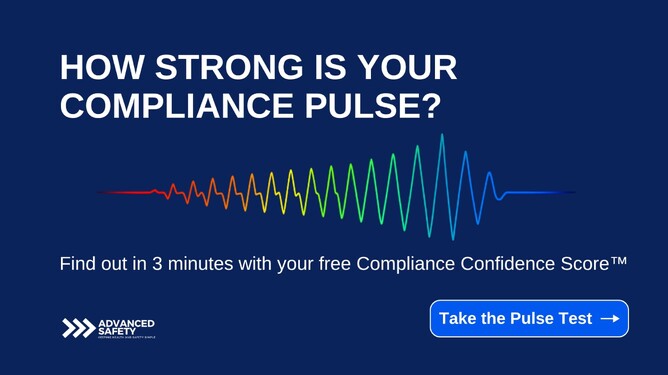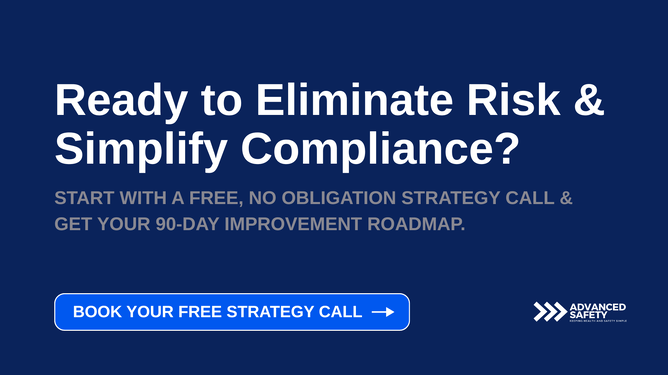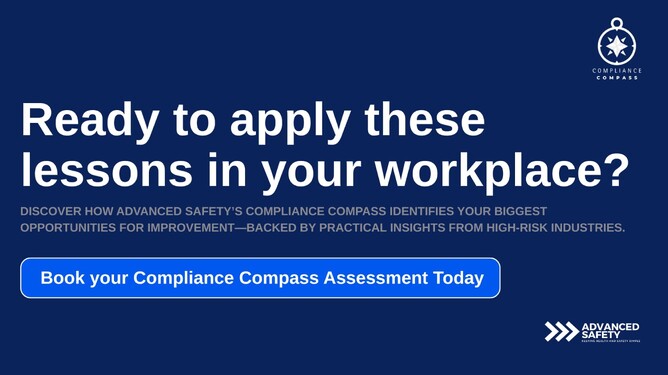Discover actionable lessons from high-risk industries like mining and pharmaceuticals to strengthen workplace safety, compliance, and efficiency across New Zealand.
Why Lessons from High-Risk Industries Matter
New Zealand’s health and safety leaders face growing pressure to meet compliance obligations while protecting people in unpredictable environments. The lessons from high-risk industries—including mining, pharmaceuticals, and utilities—offer practical, proven models for reducing risk, improving compliance, and optimising performance.
While our regulatory context is unique, the challenges are universal: managing risk, maintaining audit transparency, and responding rapidly to incidents. High-risk industries have had to innovate under pressure, and their solutions can now help New Zealand organisations—especially in food processing, healthcare, aged care, and transport—achieve more with fewer resources.
High-risk industries teach New Zealand businesses how to integrate safety, compliance, and efficiency through smarter systems, real-time data, and proven operational models.
Shared Challenges, Proven Solutions
Industries under intense regulatory oversight often operate with zero tolerance for safety breaches. Their insights apply directly to Kiwi businesses dealing with similar risks on a smaller scale.
Common challenges include:
Ensuring only qualified personnel access hazardous areas
Maintaining real-time visibility across operations
Responding quickly and effectively to incidents
Demonstrating compliance through defensible audit trails
Key takeaway: High-risk industries have solved these issues through integrated safety and security systems, offering a blueprint for others to follow.
Global Case Studies: Safety Innovation Under Pressure
PotashCorp, one of the world’s largest fertiliser producers, replaced legacy systems with Gallagher’s integrated access control and intruder alarm solution. This upgrade centralised control, video integration, and emergency muster reporting—improving visibility across its Lima and Ohio sites.
Results:
$20,000 saved immediately from system upgrade
$70,000 additional savings from controllers and readers
Real-time muster reporting strengthened emergency preparedness
Lesson: Smart integration goes beyond compliance—it creates a safer, more accountable workplace.
Read the full case study on Gallagher’s site.
Aurora Cannabis – Balancing Safety and Compliance
Operating in a highly regulated sector, Aurora Cannabis needed a scalable solution that met Health Canada’s strict requirements. Gallagher’s Command Centre with Milestone XProtect integration enabled Aurora to manage access, presence, and video documentation across multiple facilities.
Results:
Full compliance with Health Canada’s reporting standards
Improved operational oversight and transparency
Seamless rollout across multiple sites
Lesson: Integrated systems simplify compliance and deliver operational control in complex environments.
Read more here.
Local Example – Port of Tauranga
The Port of Tauranga, New Zealand’s busiest port, required a scalable safety system to manage high volumes of people and goods. Gallagher’s Command Centre allowed the port to automate facility usage tracking and control access by user groups while maintaining compliance with the ISPS Code.
Results:
Increased throughput without additional headcount
Improved efficiency through automation and video verification
Strengthened compliance and safety culture
Lesson: Even in high-volume environments, integrated systems enhance both compliance and productivity.
Read more about enhancing efficiency and safety with access control.
What New Zealand Safety Leaders Can Learn
1. Regulated Industries Lead Innovation
Industries operating under pressure are early adopters of safety technology—like competency-based access control, automated incident alerts, and centralised audit logs.
Implication for NZ:
If these tools work in mining or pharmaceuticals, they can work in healthcare, aged care, or food production. The technology is proven—the opportunity lies in adaptation.
2. Audit Trails Reduce Stress
Manual records are time-consuming and error-prone. Digital audit trails integrated with workforce management systems simplify reporting and support defensible compliance.
Automated access logs and digital reporting make WorkSafe inspections and internal reviews faster, easier, and more accurate.
3. Integrated Systems Protect People First
Safety isn’t just compliance—it’s care. Integrated systems detect incidents faster, improve communication, and prevent harm.
Implication for NZ:
Tools like duress buttons, lone-worker alerts, and real-time personnel tracking can be life-saving where response time matters most.
Applying These Lessons to Your Industry
Healthcare and Aged Care
Protect staff working alone with duress alarms and live monitoring
Restrict access to medication and treatment areas
Maintain digital incident records for fast investigations
Food Processing and Manufacturing
Limit machinery access based on verified training
Monitor hygiene zone compliance automatically
Trigger alerts for unauthorised access or equipment misuse
Utilities and Infrastructure
Control access to critical infrastructure remotely
Enable real-time monitoring of isolated sites
Support compliance with environmental and safety obligations
Barriers to Adoption—and How to Overcome Them
1. “We Already Have Security Systems”
Yes—but are they integrated with safety workflows? Many organisations operate siloed systems.
Tip: Map where your current systems intersect with safety needs—you may already own underused capability.
2. “It’s Too Complex to Change”
Change management is challenging, but so is inaction. Manual systems create blind spots and risk.
Tip: Pilot integration on a single site, measure success, and scale.
3. “We Don’t Have the Budget”
Integrated systems can deliver long-term savings by reducing incidents and audit costs.
Tip: Frame investment as risk reduction and efficiency, not just technology spend.
The Strategic Opportunity for NZ Safety Leaders
Security is no longer just about keeping intruders out—it’s about protecting people, assets, and reputation. For Kiwi safety leaders, the question is:
How can your existing systems do double duty—supporting both compliance and care?
By learning from high-risk industries, New Zealand organisations can move from reactive compliance to proactive protection. The technology exists. The lessons are clear. The next step is yours.







